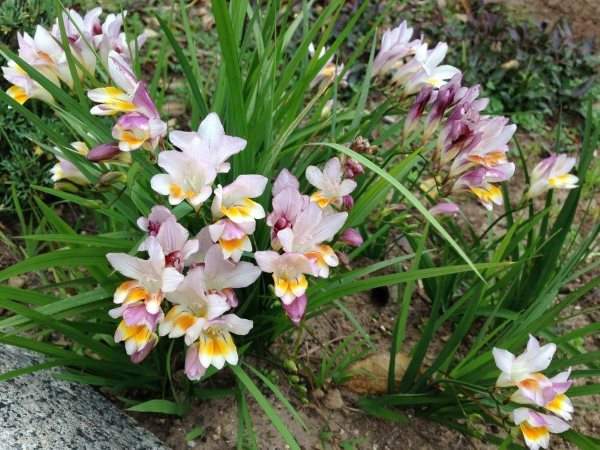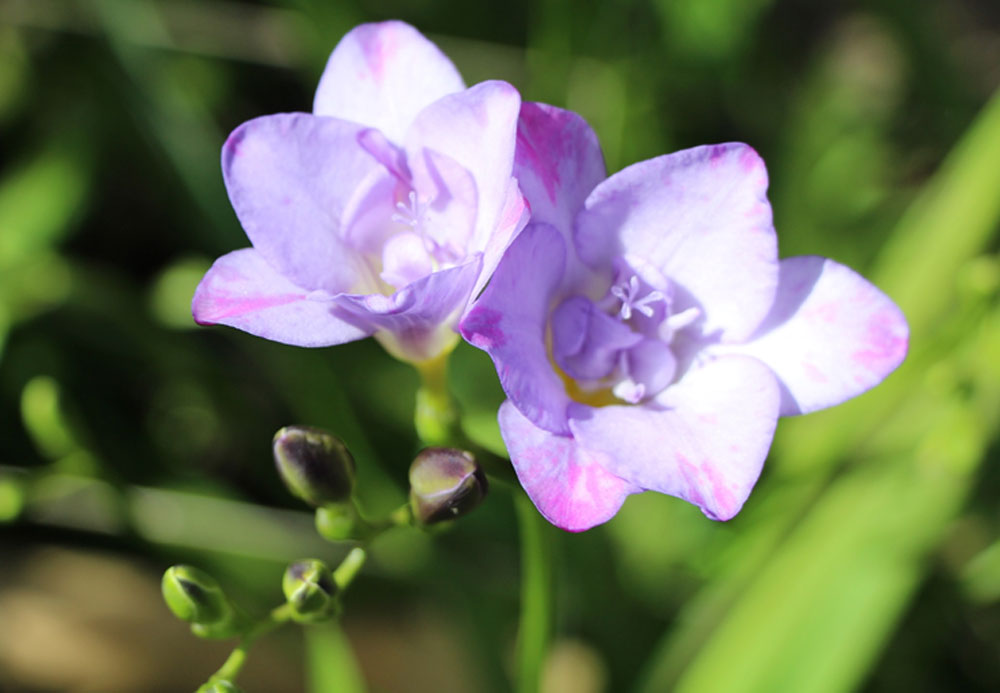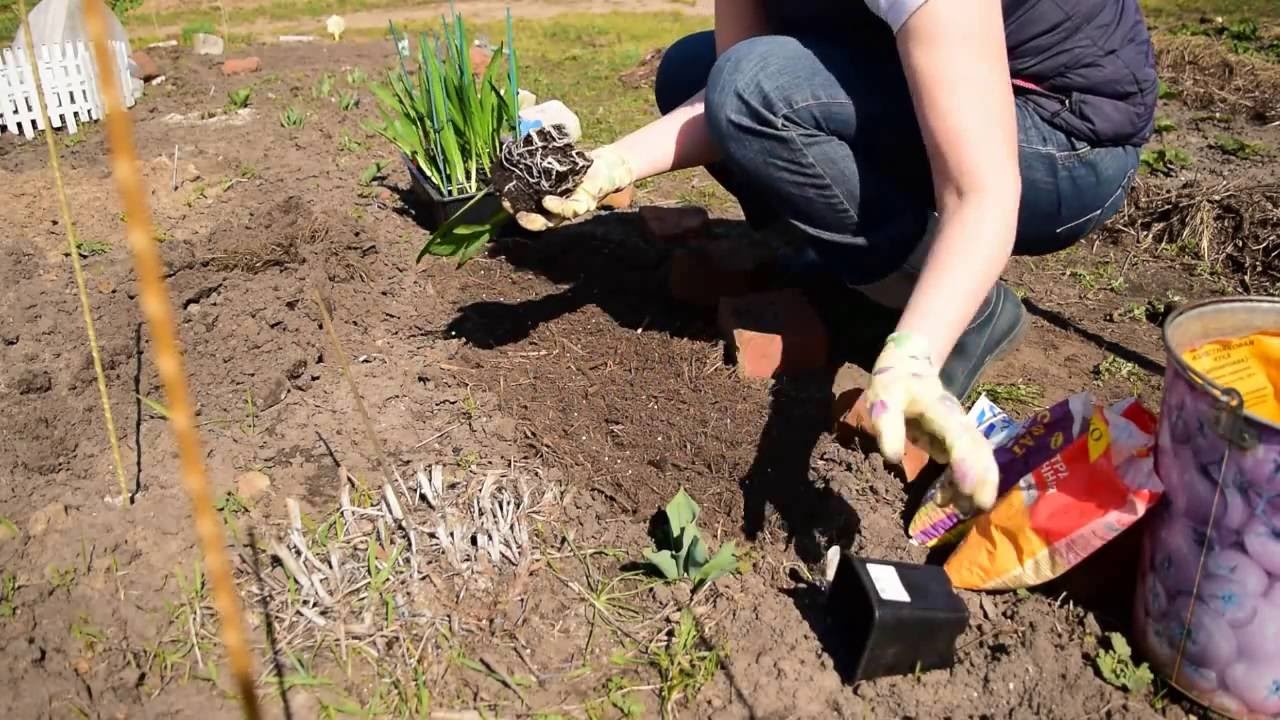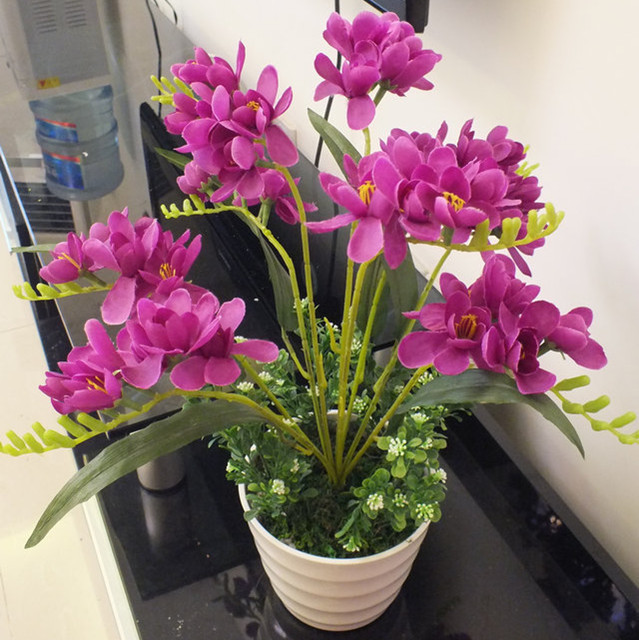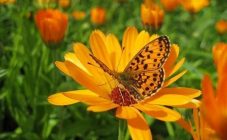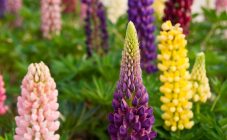Content:
One of the most beautiful flowers is freesia, growing and caring for it correspond to the rank of an aristocratic culture. Freesia is native to South Africa. This flower is considered to be truly royal. The gardeners of monarchs in France were successfully engaged in the development of varieties of this culture back in the 19th century. Exquisite bouquets adorned the walls of palaces and royal chambers. Since that time, freesia has had the status of an aristocratic flower.
Brief description of culture
The petals of this graceful, fragile and delicate plant have a variety of colors: from pale pink to blue. The stems of freesia are thin and long, covered with narrow, dark green xiphoid leaves. At the tops of the shoots are elegant racemose inflorescences.
Freesia is a perennial plant from the Iris family. Since the culture first appeared in hot climates, it cannot tolerate severe cold weather. About 10 years ago, the flower was grown only in greenhouses for cut. However, thanks to breeding work, it was possible to develop new varieties suitable for growing in the open field not only in the southern regions of Russia, but in the western part of the country. In total, more than 20 types of freesia are known, of which only 3 are cultivated for home and garden cultivation.
The plant reaches a height of 1 m. The stem of freesia is highly branched. The flower has a corm covered with scales. The leaves are thin (only 1-1.5 cm wide), long (15-20 cm), a vein runs in the center of the plate. The flowers are 3-5 cm long. They grow in inflorescences, which are located in small numbers on one side of the stem. The color of the flowers can be very different (white, blue, orange, cream, purple, pink, etc.). The fruit of freesia is a capsule.
Freesia: care and cultivation in the open field
Cape lily of the valley is a moisture-loving plant that requires constant soil moisture. Therefore, it must be watered often, but in moderation, otherwise an excess of water will lead to death. Freesia prefers moist air, but it is important to keep water away from the petals and buds when spraying. A suitable time for this is early evening (around 17.00-18.00). The plant does not like extreme heat (oddly enough for a "native" of South Africa) and too cool weather. Such conditions lead to a change in the shape of the flowers and the appearance of empty buds.
The flowering culture continues for one or one and a half months. This period can be increased by cutting off the main shoot by 1/3. Fertilize the flower 2 times a month with potash and phosphate fertilizers.
To prevent aphids and spider mites, freesia is sprayed with soapy water twice a season.On the other hand, rot may appear on the leaves from waterlogging, then the flower should be immediately treated with potassium permanganate or foundation.
Cutting the buds is allowed only after at least 2 flowers have opened. Withered buds need to be removed so that they do not deprive the newly formed flowers of nutrients.
Site preparation, soil and planting material
The key to the active development and lush flowering of the freesia plant is cultivation and care in the open field in compliance with all the necessary instructions and recommendations.
Freesia needs natural light every day for half a day. In this case, direct sunlight has a harmful effect on plants. The best condition for a flower is partial shade. It is also necessary to provide protection against drafts. The soil should be loose with a good drainage system. The composition of the soil should be present in the same amount:
- humus;
- sod;
- peat;
- leafy land.
The acidity of the soil should be low. The distance between the bushes depends on how the crop is growing. If the flower is sprawling and broad-leaved, then the varieties are planted away from each other so that they can develop freely. Varieties with narrow leaves and small flowers are more compact.
Freesia reproduces in several ways:
- seeds;
- corms;
- tubers.
For planting plants in open ground, the second option is optimal. If the bulbs of an adult plant are used for this, then they must be stored in a dry room with good ventilation and an air temperature of 25 ° C to 27 ° C. At the end of winter, this figure should be reduced by about 3 times. Failure to comply with these requirements will lead to the fact that the peduncles will not be able to develop.
Before planting freesia, you need to carefully prepare the planting material. Tubers are prepared for placement in the ground in early March. The process is as follows. Freesia bulbs are placed in pots with soil. There are 6 tubers per vessel with a volume of 3 liters and a diameter of 12-15 cm. The pots are placed in a well-warmed (25-27 ° C), humid room. For 15-18 days, it is important to ensure that the soil does not dry out. After this, the line "aristocrat" is ready for disembarkation.
When and how to properly plant freesia in open ground
Planting freesia and caring for it involves the following conditions.
First, holes are prepared with a depth of 5-6 cm.The distance between them should be from 6 to 12 cm, everything depends on the size of the bush. The plot in the garden should be shaded and windless, and the soil should be fertile, loose, drained. It is advisable to add a little peat or humus to the soil (layer thickness 4-5 cm). Before placing the bulbs, the soil must be properly loosened (30-40 cm deep) and small pegs inserted into it, so that in the future the plant can be tied up.
Do I need to dig freesia for the winter
Freesia can be grown throughout the year, but since the plant is not adapted to cold weather, it will not tolerate wintering in the open field. Therefore, tubers must be removed from the ground in autumn. Store the bulbs in nets in a warm, damp room. Some experienced gardeners recommend storing tubers in dry peat. If there are no cold winters in the region, then freesia can be left in the ground, providing it with shelter in the form of fallen leaves or spruce branches.
Agrotechnics of freesia in a pot
This plant is great for home growing. Under indoor conditions, freesia begins to bloom in the winter.
Drainage and charcoal are placed at the bottom of the vessel, and then soil is added. The diameter of the pot should be 15 cm. It is advisable to feed the plant with potassium-phosphorus mixtures. There are 6 bulbs per pot. Then the vessel is placed in a cool, well-lit place, without watering until the first leaves appear. Then the pot is transferred to a warm room and watered regularly.
For freesia, you need to create additional lighting. For this, fluorescent lamps will do. It will also be enough to keep the flower on the western or eastern windowsill. Indoor crops need support, so it is important to install special supports for weak shoots. It is recommended to water the plant with clean, settled water. During the flowering period, watering should be intensified. Freesia should be fed once every 2 weeks until the leaves wilted. Mineral fertilizers should be used as top dressing.
Features of growing freesia in the Moscow region, Siberia, the Urals
Siberia has a harsh climate, the air temperature can reach -40 ° C. In spring, the ground does not warm up for a long time. Therefore, planting the plant begins in the third decade of May. Moreover, especially thermophilic varieties of freesia in these places should not be grown at all.
Cape lily of the valley should be planted in an area with partial shade, as the plant does not tolerate heat. In the regions of Siberia, bulbs have to be planted at home in late March - early April. Tubers are rooted in open ground only in late May - early June.
In the Urals, all bulbous crops, including freesia, are dug up after flowering. You need to store them in special conditions:
- storage of corms at a temperature of 25-30 ° C;
- ensuring constant humidification by placing the pot in a tray with water (the bottom of the container should be with holes).
In this form, the tubers are stored until spring. In the third decade of March, 5-6 tubers are planted in the prepared soil in a pot. The vessel is placed in a cool place.
In the Middle Lane (Moscow region), growing freesia in the open field requires the following conditions to be met:
- the site must be sunny (light partial shade is acceptable);
- a drainage system is needed;
- the soil should be fertilized with organic matter (peat, moss, manure);
The bulbs are planted in the first or second decade of May. Place them in the soil with the pointed end up. The land around the tuber is thoroughly watered.
Among the most beautiful, but at the same time very delicate flowers, freesia occupies a special place; planting and caring for it in the open field requires special skills and knowledge. This "aristocrat" is not intended for widespread cultivation. As an option for garden and home culture, it is best suited for experienced flower growers, but novice gardeners may try to grow Cape lily of the valley. In any case, this is a good opportunity to gain valuable experience.
